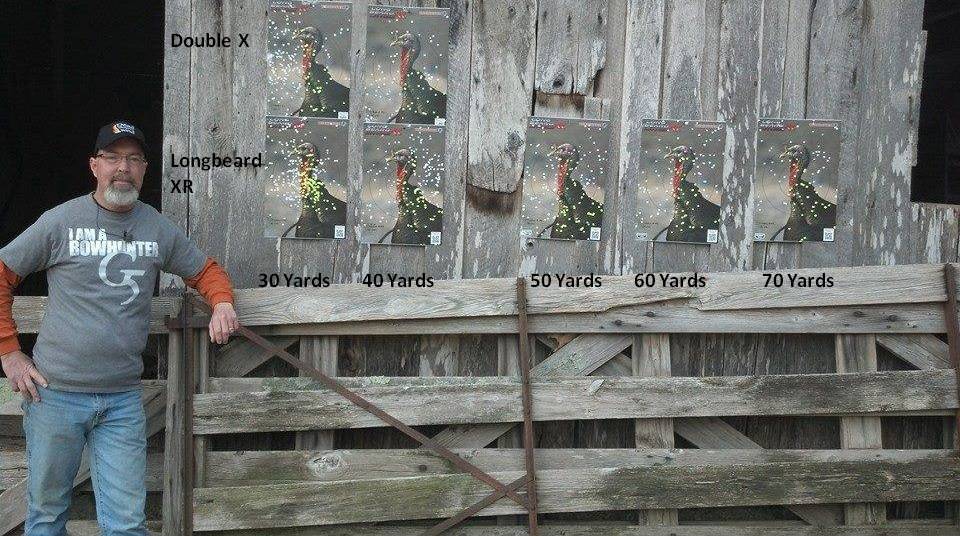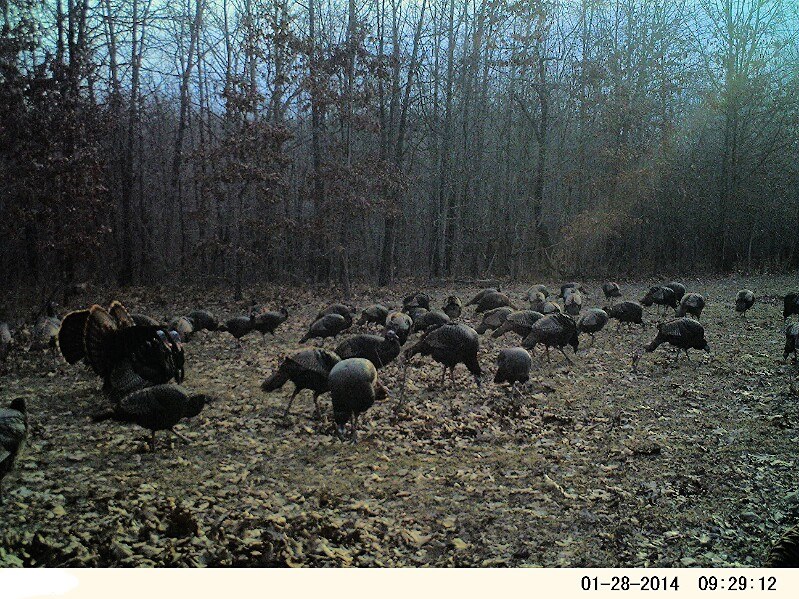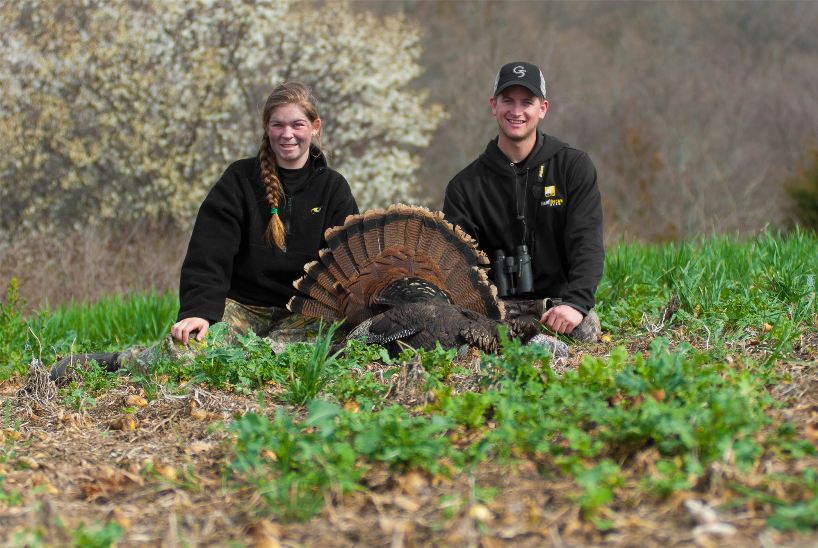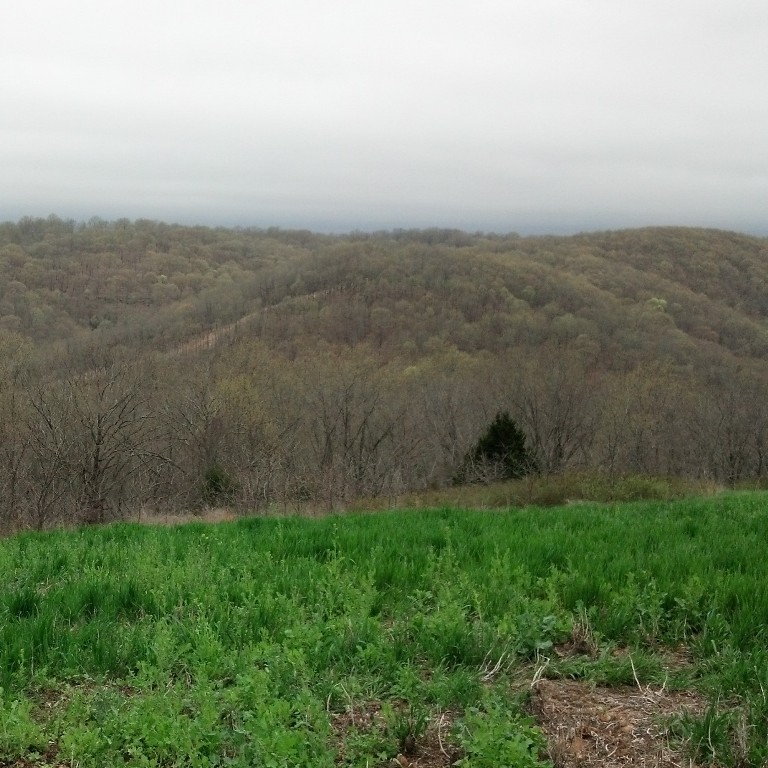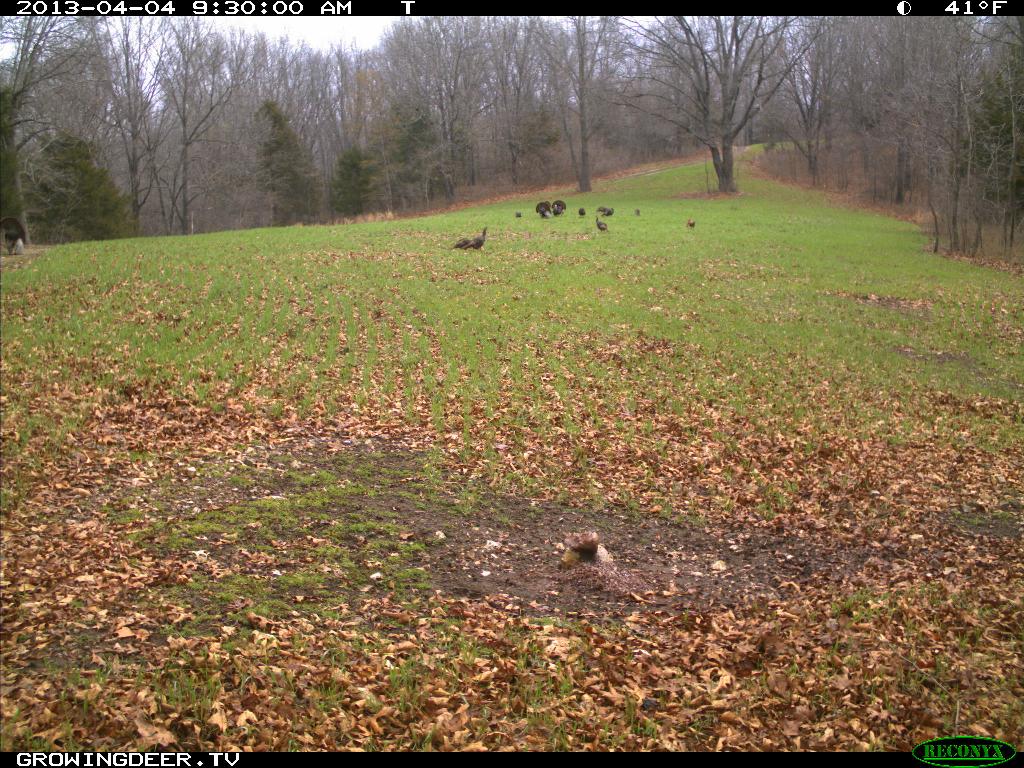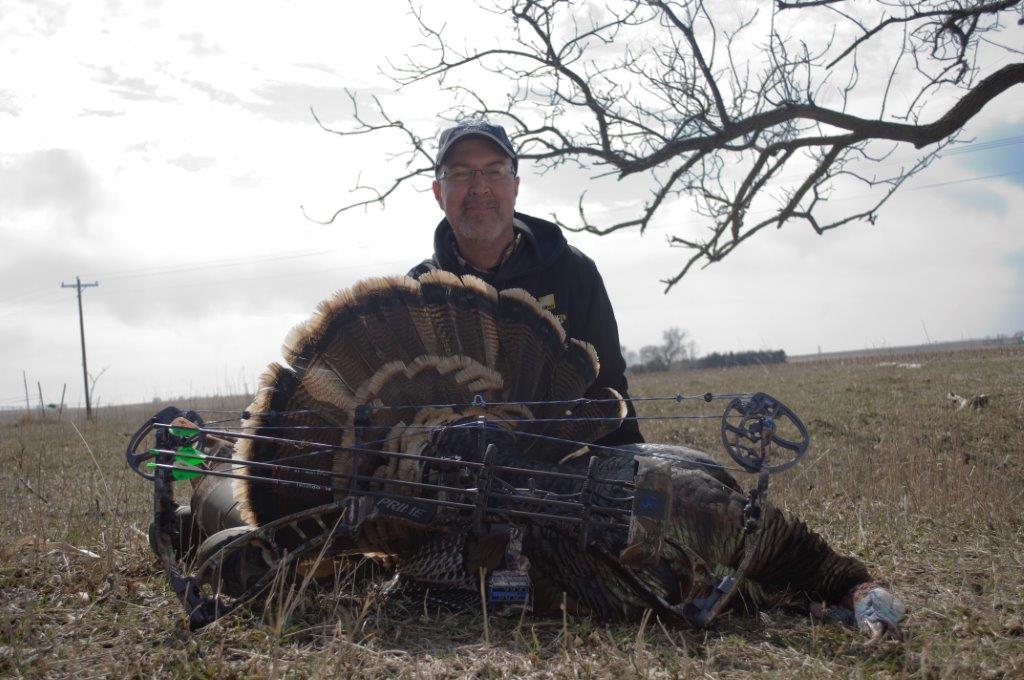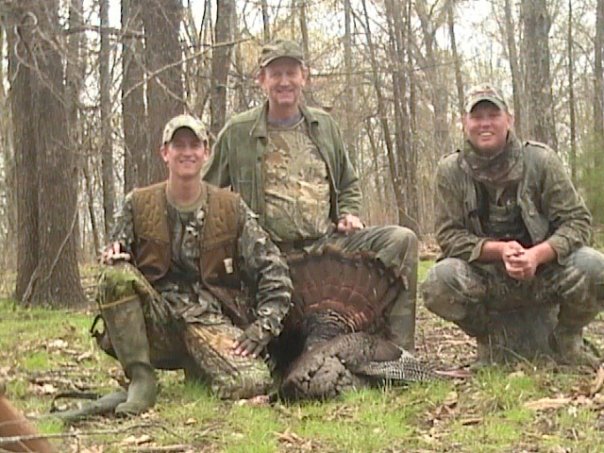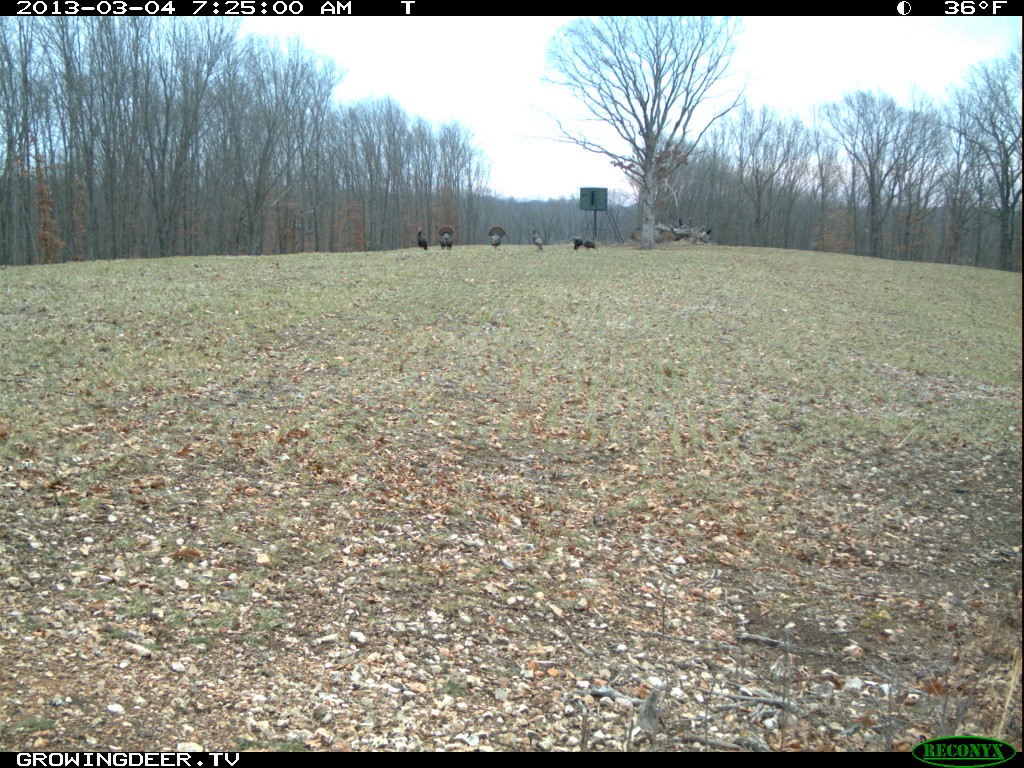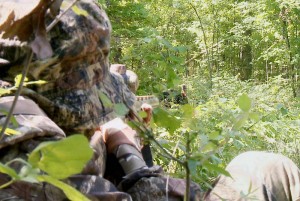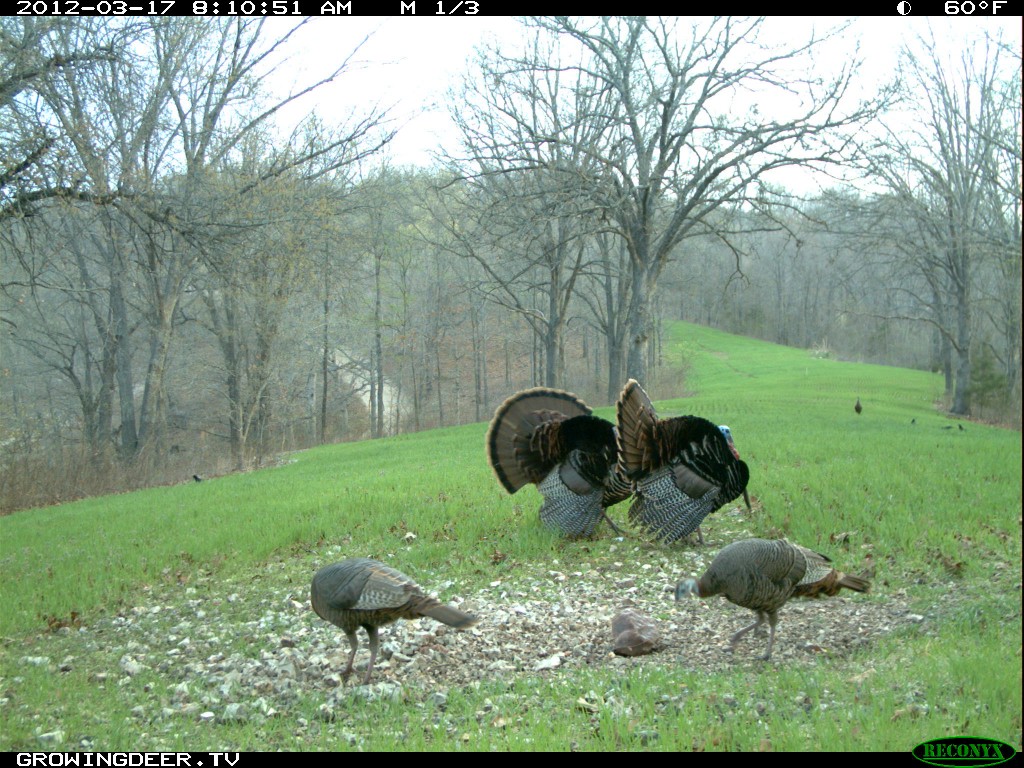Category: Turkey Hunting
Turkey Hunting: Testing The Gear
It’s always important to take some time before every turkey season and pattern your shotgun. This year was a little more exciting than usual for Grant and me. Our usual routine consists of packing up the Caldwell Lead Sled and Stable Table, throwing in our Winchester Double X’s and heading to the field to take a few shots. We typically expect the same results as we use the same gear from one year to the next. Lucky for us we had a couple boxes of the new Winchester Longbeard XR this year, and our excitement was almost more than we could bear!
Arriving at our usual location we unloaded our target and stepped back to thirty yards and setup our Stable Table and Lead Sled. First we wanted to fire off our usual Double X ammo and see the results. Next came the fun part, shooting the new Longbeard ammo! WOW! Both of these loads certainly provided enough power to take down a tom at 30 yards but there was definitely a difference in the two. Next, we stepped back to forty yards away and prepared for more shooting. After shooting both Double X and Longbeard XR at forty yards we were grinning from ear to ear. Of course both would kill a turkey at that distance, but it was still exciting to see how they were different in pellet amounts. Longbeard XR had our attention!! Always wanting to “find the ropes,” so to speak, Grant and I started backing our gear up for a fifty yard shot. In years past we wouldn’t push our luck at this distance when shooting at turkeys, but seeing the performance we were getting out of the new load we wanted to see the results. At fifty yards the pattern was still incredible! Over twenty pellets in the head and neck! Stepping it back ten more yards I waited with anticipation as Grant loaded the gun and took aim. Hearing the blast of the shotgun, I looked down range and was shocked to see that there wasn’t much difference at all between our fifty and sixty yard patterns. “Why not try seventy yards?” Grant asked. Moving back to seventy yards we discussed that we would not consider taking a shot at a turkey at that distance, but we both wanted to see the pattern. At seventy yards with Winchester Longbeard XR ammo we had 14 pellets in a turkey head target! 14!! Grant and I looked at that target in disbelief and excitement. “How is this even possible?” I asked him. We stood there smiling, and as if we needed anymore help getting excited for turkey season, we had it.
Patterning shotguns is always an important part of preparing for turkey season. I hope you take the time this spring to pattern your shotgun. Hopefully you have as much fun as Grant and I did!
Daydreaming of gobbling turkeys!
Adam
Finding The Flock: Using Trail Cameras For Early Scouting
It’s mid February and for a lot of guys like me, that means cabin fever. Deer season has been closed for awhile now for most of us and the boredom has started setting in! This time of year bores the socks off me and a lot of other people. The only hunting activities we can really get involved in are shed hunting and predator hunting. If you’re anything like me, you’ll usually bury your head in a turkey hunting magazine and dream about the warmer temperatures of spring and all the great activities associated with it.
One important thing I do to prepare for those days is keep my Reconyx cameras out and monitoring the turkeys. Locating the turkeys this time of year shouldn’t be a problem for anyone. Find the food, find the turkeys. To make things even easier, this time of year turkeys are usually grouped up in large flocks and could even reach numbers in the hundreds! We’ve received several pictures recently of these type of flocks and have shared them with you on our Facebook page. Many of you have asked questions about why the turkeys are in such big numbers and if they will stay like this until turkey season gets here.
During the summer and fall the turkeys will usually be in smaller flocks, mostly hens with this year’s young and other flocks of mostly males. As the winter progresses these smaller flocks will start frequenting the same food sources and by this time of year they’ve combined to make larger flocks. At this stage of the year they are sorting out dominance. The toms will spend a great deal of their time in “strut” trying to display that they are “The MAN!” Observing these flocks can be very entertaining! The hens are going about their business trying to eat and survive the winter, while the toms are fighting, strutting, and doing everything in their power to become “The Man.” Once they’ve established their pecking order and the spring progresses, they will begin to breakup in smaller flocks and begin their breeding season.
It’s always a fun time of year to watch the spring approach and the turkeys begin their ritual! Preparation for turkey season begins now, so be sure to get those cameras out and find the flocks and watch it all unfold!
Daydreaming of long spurs and gobbling turkeys,
Adam
After The Hunt: Cooking Wild Turkey
Grant and Adam have been busy turkey hunting this week so the writing of the blog falls to me! In considering topics I immediately knew I would not write about turkey hunting but quickly realized that I should write about what I do know – what to do with that turkey once it is “in the bag!”
When Grant and I first got married he learned that my cooking was often an “experiment” as I like to take a base recipe and “experiment” with my own ideas. Most of our meals were prefaced with “I hope this is okay. It’s kind of an experiment.” Fortunately most of my experiments turn out well! Over the years I have experimented with the venison, wild turkey and other wild meats Grant has harvested for our freezer.
I’ve become a competent wild game cook. By no means is my cooking gourmet. As a busy working mother I default to the easy recipes instead of the more complicated, fancy recipes.
Cooking wild turkey can be a bit of a challenge. Most hunters prize a “mature” tom as they are usually more challenging to hunt and a better trophy of bigger spurs and a longer beard. Being “mature” equates to old which equates to tough meat! Marinating and/or slow cooking in the crock pot are my preferred ways to turn a tough, old bird into a delicious meal for my family!
Last year I experimented with a new recipe for cooking wild turkey. Grant loved it! He said that this is his favorite way for me to cook the turkey, second only to deep frying breaded turkey nuggets.
Grant’s Favorite Wild Turkey Recipe
Serves 6
3 10 ounce cans green enchilada sauce
15 – 30 ounces chicken broth (enough to cover turkey breast)
1 large onion, chopped
3 cloves garlic, chopped
2 teaspoons ground cumin
1 teaspoon salt
1/2 teaspoon pepper
1 turkey breast (2 lbs or larger)
2 to 3 strips uncooked bacon
1 cup chopped fresh cilantro (optional; to taste)
2 tablespoons fresh lime juice
Serve with: warm flour tortillas and salsa
Mix all ingredients except turkey, uncooked bacon, cilantro, lime juice, tortillas and salsa in a 4 quart or larger slow cooker.
Add turkey wrapped in bacon strips.
Cover and cook on low 7 to 9 hours or until turkey is tender. Remove turkey to a cutting board.
Stir cilantro and lime juice into mixture in slow cooker. Shred turkey in bite size pieces; return to slow cooker.
Can be served as a soup/stew or use a slotted spoon to separate meat from liquid and serve burrito/taco style rolled up in flour tortillas with your choice of toppings: cheese, sour cream, shredded lettuce, or salsa. Accompany with refried beans, rice, salsa and chips. (If you choose to use the meat for a burrito/taco the remaining liquid makes a base for Mexican soup!)
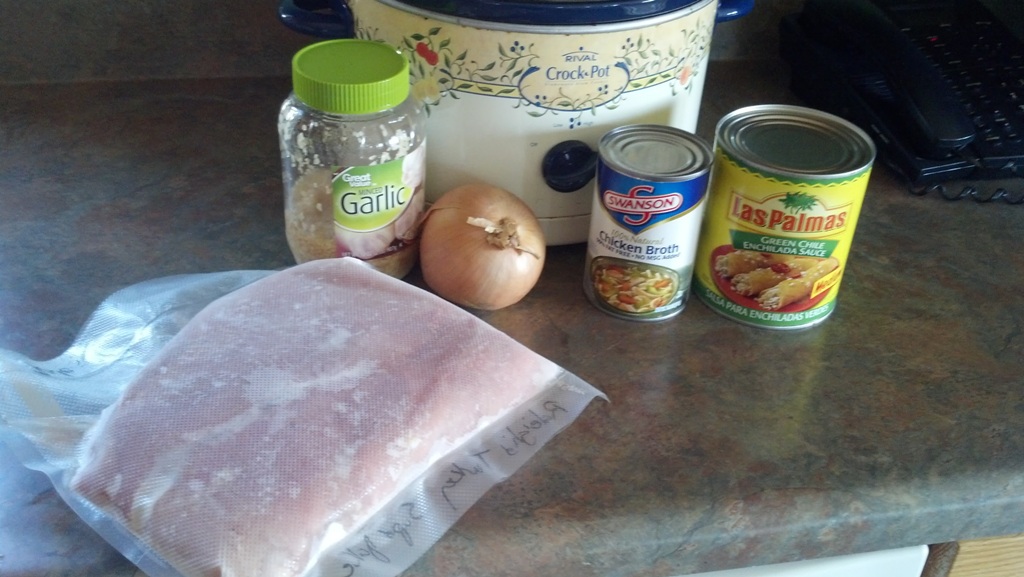
Slow cooking in the crock pot is one of my favorite ways to turn a tough, old bird into a delicious meal.
(The idea for this recipe is based on one for a Mexican pork dish I modified for venison that I call Venison Pozole.)
If you would like to try something new this year, check out these great recipes on the NWTF website or on the Bass Pro website.
Let us know your favorite recipes for cooking wild turkey by posting them on Grant’s Facebook page!
Enjoy!
Tracy Woods
Spring Turkey Hunting Strategies
The hillsides here at The Proving Grounds are slowly getting that green tint to them, the creek is flowing fast, and the gobblers are playing their song every morning. Spring is in the air here, FINALLY! Last year when Missouri turkey season opened, we had plenty of foliage and green leaves. This year’s opening day will be very different. Spring green up is occurring later than it has the last couple of years and the turkeys seem to be on that same schedule.
I’ve been asked several times lately if I’m still seeing a lot of birds in large flocks or winter to early spring flocks. The answer is yes and no. From running the Reconyx cameras to driving across the country side, I’m seeing a lot of birds in large flocks. I’m also seeing the occasional single tom out strutting in a field, but the majority of birds are still in groups. What does this mean? If you ask any turkey hunter who’s spent much time chasing turkeys they will tell you that calling to flocks isn’t nearly as effective as calling to lone gobblers. And why should it be? When a gobbler has an entire flock around him why would he leave them for one hen he can’t see? “Henned up” turkeys can also be indicated by their lack (if any) of gobbling when they fly off the roost in the morning. It will be difficult calling turkeys until they split up and we start finding more lone toms.
With the Missouri turkey season opening soon I thought I would discuss our strategy. Since we’re seeing more flocks than usual for this time of year, our game plan has changed. As much as I enjoy “running and gunning” for turkeys, it probably won’t be on the agenda for opening day this year. Hunting henned up toms that don’t gobble much is more like deer hunting. First we scout with ears, eyes, and Reconyx cameras to find the location where they are most active. Then we move in before sunrise to either a blind or a tree that we have previously picked. Finally, we generally use decoys and keep our calling softer and less aggressive. To me this type of turkey hunting is far less exciting than my favorite running and gunning style, but it can be just as effective if the cards are played right.
We’re only days away from one of my favorite events of the year! I can’t wait to wake up, pull on my LaCrosse boots, and head out in search of a gobbler. Good luck to all the hunters out there and stay safe!
Daydreaming of long beards and long spurs,
Adam
Turkey Hunting Or Planting Food Plots: Let The Weather Decide
In most states April is the beginning of turkey hunting and warm season food plot planting season! Both of these activities are very dependent on the weather!
Research has shown that more turkeys are likely to gobble when it’s a warm sunny day. Overcast, rainy, or snowing conditions tend to result in fewer turkeys gobbling. It’s tougher to hear turkeys gobbling on windy days.
I’d like to hunt every day, but I have tasks that must be completed so I can hunt. So, I try to schedule the days I get to hunt on the days the weather conditions are the most favorable. I’m not aware of any accurate long-term weather forecast (if you are please let me know). The most reliable forecast I’ve found that doesn’t include any advertisements or hype is from the National Weather Service’s Climate Prediction Center. I often check their website and look at the cool maps on the 3-7, 6-10, and 8-14 day forecast.
Last week I used these forecasts to change the days of a scheduled turkey hunting trip to Nebraska. I avoided a couple of windy/snowy days and arrived two days later to sunny 50+ degree weather! The turkeys responded well and I was able to tag a 28 pound tom with my Prime bow!
I’m also very interested in the soil temperature this time of year. My clients and I plant corn when the soil temperature is about 50 degrees and soybeans when it’s about 60 degrees. I use a soil thermometer at my place but use data collected daily by universities in many states when helping others determine when to plant. For example, the soils are still a bit cold to plant in Iowa based on data Iowa State University publishes daily on the web.
We are preparing to plant soybeans for wildlife at one of my projects on the North Carolina coast. Even though I’m in Missouri, I can check the soil temperature and help the guys onsite determine when to plant by checking the North Carolina State University website.
Weather has a huge influence on deer and turkey activity and the success of food plot crops. Check out the sources above before planning your next hunting or habitat management activity!
Growing Deer (and turkeys) together,
Grant
Turkey Hunting: Tips To Avoid Mid-Season Mishaps
He stood only 45 yards away in a small clearing where he had spent the entire morning strutting and gobbling. Shooting hours for the day were coming to a close and I knew the time was now or never. I let out a soft yelp and as he raised his head I squeezed the trigger.
“Larry Long Spurs” was my arch nemesis during the 2005 and 2006 spring season and I hunted him almost every chance I could get. He didn’t always roost on our farm, and he wouldn’t gobble every morning, but on this particular hunt I had been lucky enough to roost him the night before. I was waiting for him the next morning when I heard his first gobble ring out breaking the morning silence. Being a novice turkey hunter in those days I made a few mistakes that I paid dearly for. The first mistake was my original setup. I had setup too far back and had to use the entire morning to crawl within range.
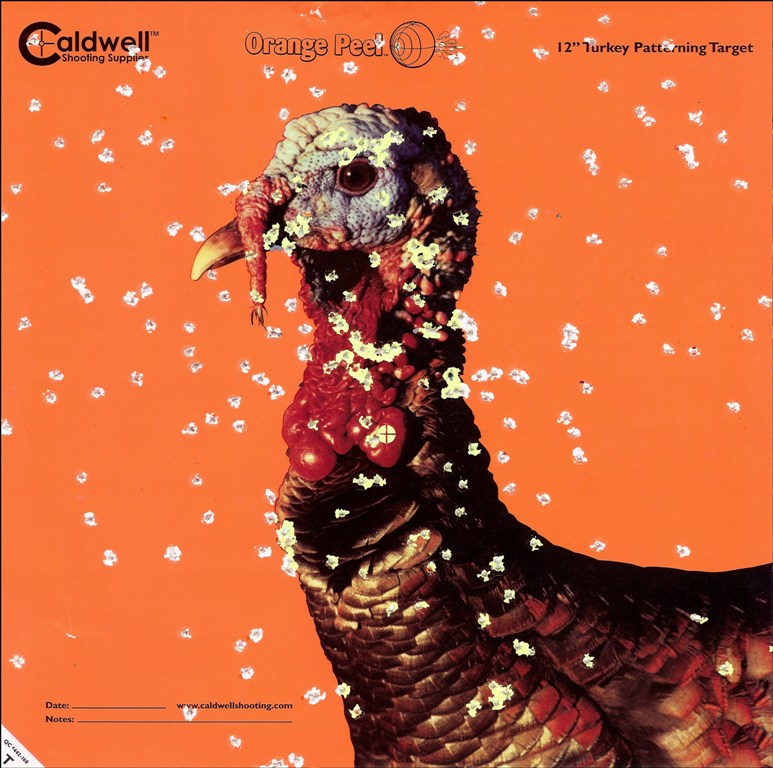
I use the Caldwell Stable Table and Lead Sled to pattern my shogun in preparation for the upcoming turkey season
The second mistake, a mistake that to this day upsets me; I didn’t test my gear before heading into the woods. In those days I weighed 120 pounds soaking wet but I wouldn’t allow anyone, especially my friends, to think I was too small for a 3 ½” turkey load. I was a little man with way too much gun power, so there was nothing pleasant about shooting my turkey gun at anything other than turkeys! That is where I went wrong. I let the fear of getting kicked by the gun prevent me from patterning my gun. I had found a cheap box of shells in a catalog and bought them to use on turkeys. When I hit the woods to hunt a turkey I wanted more than any other bird before, I had no idea how my shotgun patterned. BIG MISTAKE!
As turkeys scattered and I gathered myself from the initial shock of the gun blast, I jumped to my feet and ran to the opening where he had been standing. I found nothing: no Larry Long Spurs, no feathers, and no more faith in my shooting ability. I had blown the only chance I would get at him and all I could do was wonder what went wrong. Returning to our cabin I decided to shoot my shotgun and see what kind of pattern I was shooting. I can summarize my findings by saying that at 45 yards a beach ball would have had a good chance of survival.
Today, not a season goes by that I don’t take the time to pattern my shotgun. All fear of being kicked into submission is gone now that I use the Caldwell Stable Table and Lead Sled. No more are the days of leaning against a tree and hoping I could get the results I wanted before shooting more than a few times. Patterning my shotgun went from being a dreaded activity, to an enjoyable time in preparation of the upcoming season. Top that off with Winchester Double X turkey ammo and now I have complete faith in my gear every hunt.
It’s that time of year to get out and pattern those shotguns! Don’t make the same mistakes I did! Always remember to be safe and good luck turkey hunting!
Daydreaming of long spurs and long beards together,
Adam
Turkey Hunting: Scouting Made Easier
It’s March 14th and we’re almost a month away from Missouri turkey season! Most people who know me know that I am absolutely obsessed with spring turkey hunting! I love the months of March, April, and May for many reasons: the fishing is picking up, the woods are greening up, the morel mushrooms are popping out of the ground and most important the turkeys are doing their spring rituals! One of the biggest reasons I love chasing turkeys every year are the memories from past years that resurface every time I’m out there. My first turkey with my father (on what is now my favorite place in the world to chase turkeys), my first turkey taken when hunting and calling by myself, my four bearded turkey killed moments before getting completely soaked in a thunder storm and so many more. Reasons for having so many memories are due to the fact that I was turkey hunting with my dad years before I was a deer hunter.
Thinking back to the early days of turkey hunting, I can’t help but look at the amount of change that has occurred. Early in my career you went to locations where turkeys were known to roost and you waited to hear a gobbler then you made your move. It’s 2013 now, and although season is over a month away my scouting has already started, thanks to our Reconyx cameras. Yesterday we began setting our Reconyx cameras to time lapse. We do this so we can scout over fields where turkeys are likely to be active, but still out of range of our motion sensors. Common trail cameras without the time lapse feature would most likely miss an old tom that was strutting a hundred yards away in the field. We position our Reconyx cameras to overlook our food plots and then set the time lapse interval to every 15 minutes. Once this is done we now are scouting our food plots without even getting out of bed in the mornings.
With our Reconyx cameras set up with time lapse on our food plots we are officially scouting and preparing for the first day of turkey season. When that first day arrives we will hit the woods with complete confidence on where and when to go!
Turkey seasons are already open in some states and are soon to open in others. Always stay safe and best of luck to all!
Daydreaming of long beards and long spurs!
Adam
The Effect Of A Warmer Spring And The 2012 Turkey Season
It’s currently turkey season in many states. I realize it’s almost over in some and hasn’t started yet in others – but it is turkey season in most states!
The temperatures have been warmer than normal in most states so far this spring, as was the case throughout most of the winter. Many GrowingDeer.tv fans told me about seeing turkeys showing breeding behavior earlier than normal this year. That was followed by reports of folks finding turkey nests earlier than normal also.
We are just wrapping up the first week of turkey season in Missouri; the gobbler behavior is certainly different than normal for this time of year. This all fits as Missouri University reports that the winter of 2011-12 was the fifth warmest on record. Flowers bloomed earlier, folks were mowing their yards earlier, farmers were planting earlier, and turkeys began breeding earlier.
This means turkey hunters may need to change strategies a bit this year. Turkeys may be using different parts of their range this year as hens will be close to nesting habitat. Gobblers will be close to hens, so hunting near nesting habitat (cover from zero to at least one foot tall) is a good strategy. Hens typically come off their nest early during the morning and gobblers will court them. Gobblers will probably be more likely to come to calls after 9 am or so when most hens will be returning to their nest. Late morning hunts may be the most productive!
The antler cycle has been different this year also. Bucks throughout much of the whitetails’ range held their antlers several weeks longer than normal – with a few still holding antlers. However, currently most bucks are showing at least 2” of new antler growth. There is no doubt the relatively mild winter will have an impact on antler size during the 2012-13 season. However, the growing conditions this summer will likely have just as much, if not more impact on antler size this fall.
One thing is for sure, I’ll be watching antler development each week between now and deer season! I’ll keep you posted what I’m seeing in the field.
Growing Deer together,
Grant
Early Turkeys?
I’ve been driving/riding across South Dakota, Nebraska, and Missouri since before daylight. Adam and I have probably seen 50 gobblers strutting during this drive. We’ve crossed 100’s of miles in latitude, driven through row crop, pasture, national forest, and river bottom habitat types. We’ve seen fallow fields, planted fields, and farmers planting fields. The one constant has been that temperatures are much warmer than normal for this time of year and it appears that turkeys are about a month ahead of their normal mating season schedule.
Last weekend was youth season in Missouri. I took both Raleigh and Rae hunting with high expectations of a double harvest during the weekend. During the past few years, adult gobblers have readily responded to my calling and a jake decoy. Those hunts resulted with turkey in the deep fryer after Raleigh and Rae tagged their toms. Many state agencies schedule youth season early during the turkey mating season as during this time gobblers usually readily respond since most hens are not receptive to toms at this time.
That scenario wasn’t the case last weekend. Both mornings my daughters and I heard toms gobbling on the roost, and both mornings toms ended up responding to my calls. However, on both mornings the toms took a very long time to respond. They cautiously approached our decoys, but remained out of range, took a look and veered off. Their behavior was very odd for this time of year – but not the conditions…
The temperatures and development of vegetation are both approximately a month ahead of normal. Fellow hunters and biologists have recently shared with me they’ve seen turkey poults already this year in multiple states. It’s very early to see or hear reports of turkey poults. Heck, regular turkey season hasn’t opened yet in Missouri!
Missouri University reports that the winter of 2011-12 was the fifth warmest winter since they’ve been keeping records. No doubt the timing of mating, development of vegetation, etc., will be different than normal. The good news is that 2011-12 was only the fifth warmest winter on record. There have been warmer winters, many years ago, and turkeys, deer, and vegetation survived well.
Even with these conditions, I look forward to opening day. I’ll be evaluating the gobblers’ behavior and adjusting my hunting strategies accordingly. That’s a great thing about hunting – every year is different and every day in the woods offers an opportunity to learn and improve our hunting skills.
I’ll share what I learn and hope you join the GrowingDeer.tv Team and share back with us so we can all learn together.
Growing Deer (and learning) together,
Grant
Youth Turkey Season
Youth turkey season begins tomorrow in my home state of Missouri! I plan on taking my oldest daughter, Raleigh – 13, tomorrow morning and my younger daughter, Rae – 10, tomorrow afternoon. It’s legal to hunt turkeys from sunrise until sunset in Missouri during youth season, and only until 1pm during the regular season (starting in two weeks).
I’ve been using my Reconyx cameras in an effort to pattern turkeys. I’ve placed the cameras overlooking food plots that I know from past experience are areas where gobblers like to strut.
Using this technique, I have located two plots that turkeys are frequenting somewhat regularly. I enjoy cut and run turkey hunting, but not for taking my daughters, especially Rae. Patterning turkeys and using a ground blind is an outstanding technique and allows much more father/daughter time and conversations!
I think I’ve crossed another hurdle this year. Last year, a large gobbler hung up on Rae and I about 150 yards out (GDTV 73). That turkey stayed on the ridge for more than an hour! That’s a long time for any hunter to hold a shotgun – but close to impossible for a 9 year old. This isn’t as large of a feat if the hunter is sitting on the ground with his back to a tree. He can rest the gun on his knee and find a time to move it slightly as the tom approaches.
However, taking a gun from leaning in the corner of a blind to sticking out the window (about 2”) for a 9 year old can be tricky – especially after watching a strutter for more than an hour! This year I have a Caldwell DeadShot FieldPod. Simply stated, it’s a very light, tri-pod (stable) that holds both the front and back of the shotgun. I actually got if for me for long range predator hunting, but tried it yesterday with Rae’s 20 gauge and decided it was perfect for a youth hunt in a turkey blind.
I’ll share the results of using the Reconyx to pattern gobblers and hopefully how Raleigh and Rae liked the DeadShot FieldPod next week.
No matter what happens, I’m sure the time in the blind will be a trophy for my book!
Growing Deer (and children) together,
Grant



